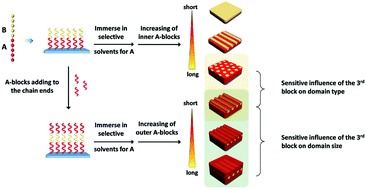Tethering solvophilic blocks to the ends of polymer brushes: an effective method for adjusting surface patterns
Abstract
The effect of different lengths of solvophilic A and C blocks on the assembled configuration of intermediate solvophobic B-blocks in both ABA and ABC polymer brush systems is investigated via dissipative particle dynamics simulations. For the AB diblock copolymer brush with solvophilic A-blocks being grafted to the surface, B-blocks self-assemble into spherical micelle structures that are immersed in a layer formed by the A-blocks. Tethering a very small solvophilic block A(C) at the free end of the polymer brush pulls the B-blocks toward the polymer brush/solvent interface and increases their local density which can significantly change the B-block self-assembled structure from spherical micelles to ripples. By increasing the length of the outermost solvophilic blocks, the lateral density distribution of B-blocks can be further changed, resulting in the domain size of the ripple structure first decreasing and then increasing. Compared to the ABA system, the incompatibility between the A and C blocks can effectively reduce the vertical domain separation caused by the fusion of the upper and lower A blocks. Then, based on an AB diblock copolymer brush system with self-assembled spherical micelles, we introduce extremely short free solvophilic blocks A(C) in dilute solution that can be tethered to the free ends of the polymer brush by using a reaction model [Liu et al., J. Chem. Phys., 2007, 127, 144903]. We find that the micelles' coalescence is mainly affected by the content of tethered reactive solvophilic blocks, and only weakly affected by the reaction rate of the reversible reactions. This strategy of tethering solvophilic blocks to the ends of polymer brushes can be an effective way for the fabrication of stimuli-responsive surfaces and for adjusting nanoscopic surface patterns.



 Please wait while we load your content...
Please wait while we load your content...